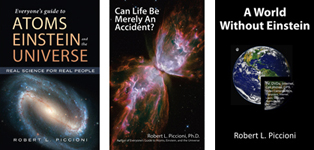|
I am fascinated by the yet-unanswered question of how life first originated.
I don’t
mean how life-forms procreate and evolve from one generation to the next
— all that is very well explained by genetics and Darwinian evolution.
But how did the very first living thing become alive?
For most
of a century, scientists claimed life began in a “warm little pond” from
spontaneous chemical reactions. The vast majority of scientists held
the view best enunciated by former Harvard professor of biology and
Nobel Laureate George Wald. He said: “However improbable…given enough
time it will certainly happen…the ‘impossible’ become possible, the
possible probable, and the probable virtually certain. One only has to
wait: time itself performs the miracles.”
But not
all agreed. Sir Fred Hoyle said life arising through random chemical
reactions was “as likely as the assemblage of a 747 by a tornado
whirling through a junkyard.”
In 2010, I published Can Life Be Merely An Accident?.
This book presents what I believe is the only physically and
mathematically rigorous analysis of the probability of randomly forming
the minimal genetic code capable of sustaining any form of life. I
showed that the random formation of even the minimal DNA, even once
throughout the entire expanse and existence of our observable universe,
is absurdly improbable. Even in the most optimist scenario, the odds are
less than 1 in N, where N has more than 203,500 zeroes.
I also
showed that if there were two ways to form life, and if one way was
1/100th of 1% less favorable than the other way, then that way would be
100 billion, billion times less likely to form spontaneously than the
more favorable way. In simpler terms: only the most probable form of
life has any chance of arising. If we do ever find alien life, I predict
it will be based on DNA with the same biochemical design as life on
Earth.
When I
published these findings my views were very unconventional, perhaps even
heretical. Benedict Arnold got about the same reception that greeted me
in the scientific community.
But that
has changed. Many scientists now agree with my primary thesis that DNA
is far too complex to form spontaneously. A current Harvard professor of
biology, Jack Shostak, perhaps the world’s leading pre-biotic
biologist, has a revised theory. He thinks some very small molecule that
could self-reproduce did form spontaneously. This molecule would have
to be several billion times smaller than our DNA. Over time, Shostak
says, the descendants of this primeval molecule grew, eventually
becoming something like RNA. And over more time, RNA-like molecules
evolved into DNA.
As I
address in my book, there are huge challenges to the bootstrap approach.
Among others, even tiny genetic “life” fragments would have to
dramatically out-compete the “non-life” fragments. The “life” fragments
must survive and reproduce, but equally importantly, the “non-life”
fragments must rapidly fall apart. Otherwise all the available carbon in
the universe would be trapped within “non-life” fragments, because
those are extraordinarily more probable.
While all
my ideas aren’t completely accepted, I am gratified that now I rarely
meet a university biology professor who claims DNA was spontaneously
created. The first step toward a more sensible scientific theory is
abandoning an absurd theory.
To explore this fascinating subject, go to my website for Can Life Be Merely An Accident?, now being offered as part of a Holiday Special.
Best Regards,
Robert

Dec 9th, 2014
Note: Previous newsletters can be found on my website.
|